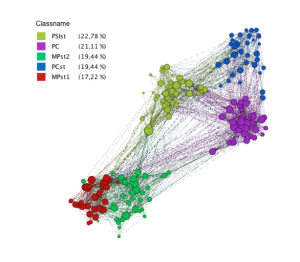The Spread of Diseases Across Networks
When students and faculty walk into Olin, Mann, or any of the other libraries around campus they are welcomed by the rustle of textbook pages, the faint typing on computers, and in early September by a chorus of coughs and sneezes. Each fall Cornell is repopulated with thousands of students who in addition to their abundance of knowledge and interests carry with them a host of germs and viruses they were exposed to over break. The close interaction of so many students leads to the spread of these viruses and disease. The Cornell Social Network, similar to other school/work social networks, is constructed in a manner that allows for diseases to spread across the population. One study has been recently conducted to determine how disease and viruses spread across networks, similar to the ways it does at Cornell.
Researchers Julie Fournet and Alain Barrat conducted a study in a high school to explore how the characteristic of face-to-face contact of individuals can affect the ways in which viruses spread. To do this they had students wear electronic badges that sense and record data when in close proximity (about a meter) to other students badges. They had 180 students wear the badges for 4 days in December 2011 and once again the following year (2012) with students of the same age and from the same school for 7 days. While these students all went to the same school they choose groups of students from different classes.
After all of the information about the interactions of the students was collected Fournet and Barrat graphed and analyzed the data. Figure 1 is one of these graphs in which the “180 nodes [represent] the 180 students, and 2220 edges [correspond] to the pairs of students who have been in contact at least once during the data collection.” One of Fournet’s and Barrat’s observations was that students tend to interact more with other students of the same gender (i.e. girls with girls, and guys with guys). Two of the more interesting observations were that (1) students rarely interact with students that are not in their classes or in similar subjects of study (notice the many interactions within classes in figure 1) and (2) the patterns in the contacts do not change much from day to day and year to year. The combination of these two qualities in the network makes for important information about how infectious diseases travel and how diseases could be contained. Fournet and Barrat propose that “the closure of single classes or groups of classes when a disease outbreak is detected could represent viable alternatives to full school closures,” useful information for schools across the globe, Cornell included.
Figure 1: Graph of the students and contact between each student:
The conclusions of this study extend to the global social networks, which we studied in class, and the way diseases spread cross country and cross continent. The world has become an increasingly connected and social place. With this connectedness comes the inevitable spread germs. As we examined, the global friendship network almost surely has only 1 giant component. However, the daily face-to-face to interactions can probably be grouped by friends, coworkers, and family members in similar ways to the classes that were seen in the high school, so that most interactions occur within the groups instead of across multiple groups. If these subgroups in the network can be identified and isolated or monitored during disease outbreak it might be possible to inhibit the spread of the disease, even if just slightly slowing the rate that it spreads.
Sources:
http://www.technologyreview.com/view/531021/human-contact-patterns-in-high-schools-hint-at-epidemic-containment-strategies/
http://arxiv.org/pdf/1409.5318v1.pdf

